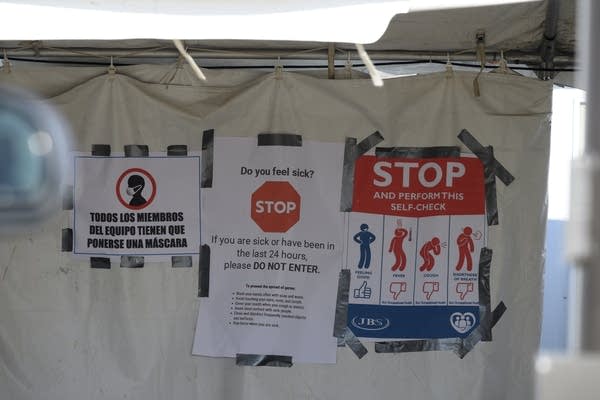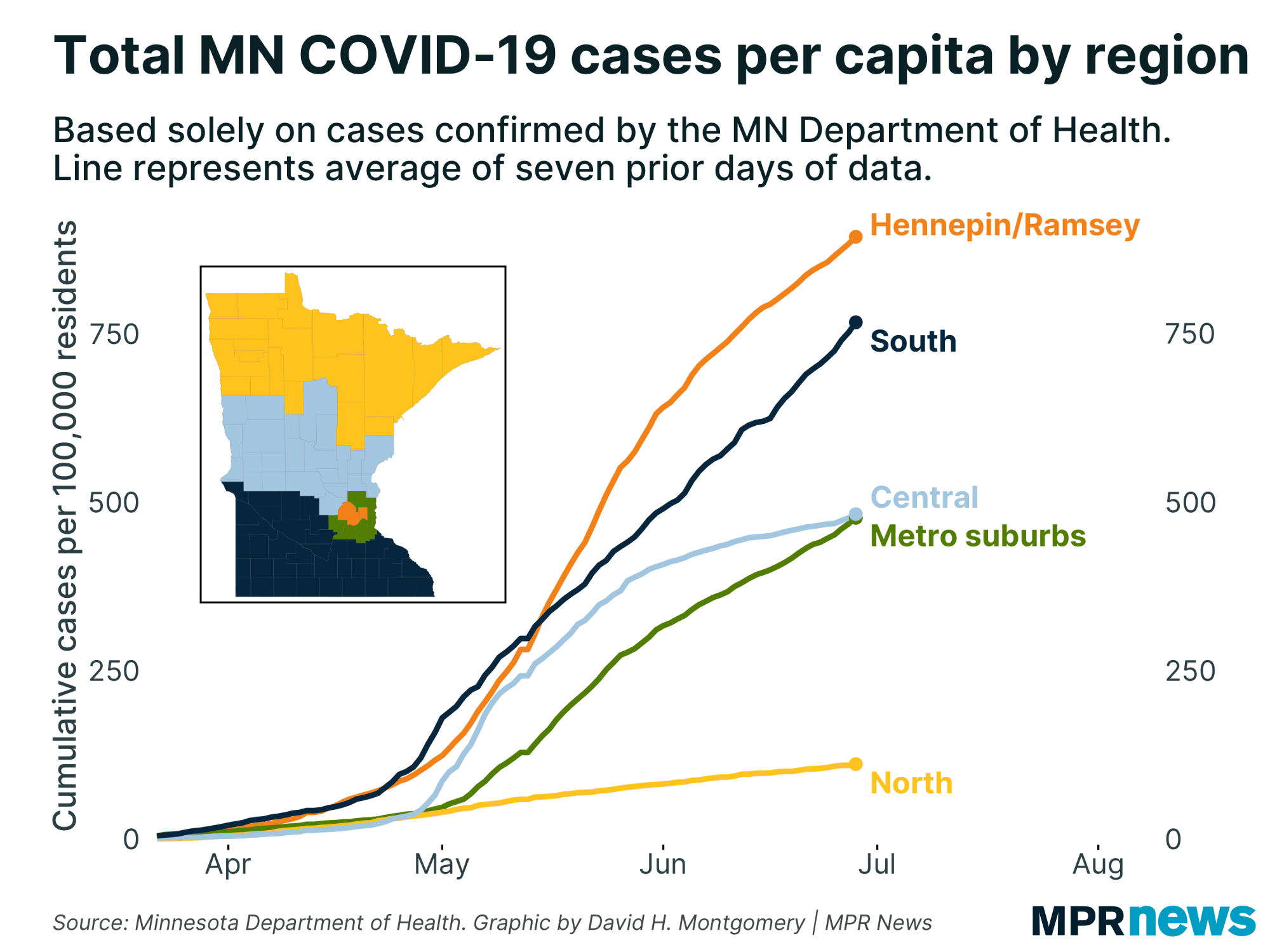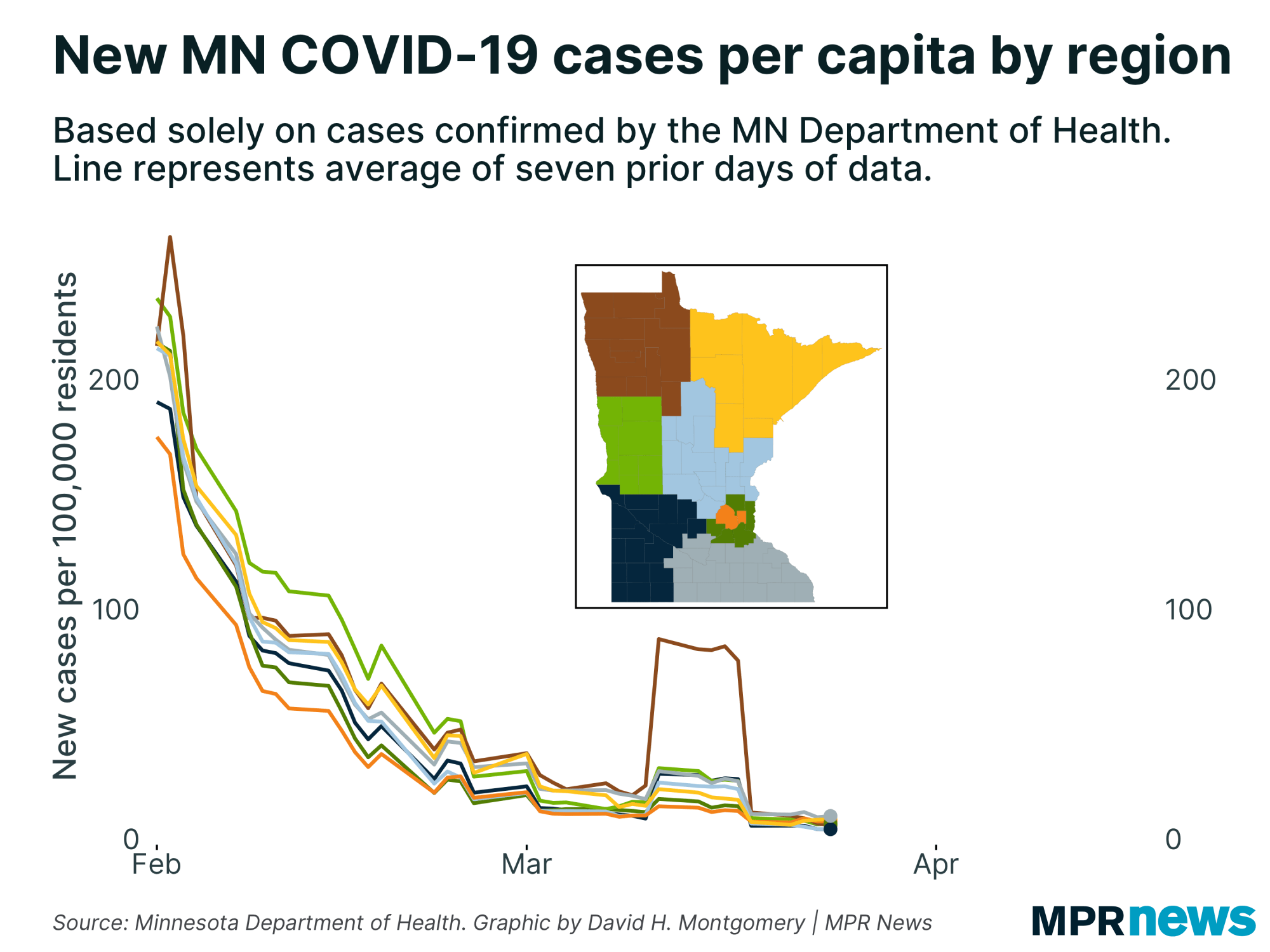Four ways COVID-19 has hit different parts of Minnesota

Go Deeper.
Create an account or log in to save stories.
Like this?
Thanks for liking this story! We have added it to a list of your favorite stories.
The COVID-19 pandemic has touched all but one of Minnesota’s 87 counties — but it hasn’t hit all parts of the state equally.
The core of the Twin Cities metro area, Hennepin and Ramsey counties, have so far seen the most cases in the state, even adjusting for population. But southern Minnesota isn’t far behind.
Central Minnesota and the suburban counties around the Twin Cities have had similar overall infection rates, but the disease has peaked in those regions at different times.
Northern Minnesota, meanwhile, largely hasn’t had any serious outbreaks, with low infection rates reported from the North Dakota to Wisconsin borders throughout the pandemic.
Here’s a breakdown of the cumulative cases per capita in each of Minnesota’s major regions.

One important caveat to note is that data relying on confirmed cases has its shortcomings. In the early days of the pandemic, access to testing was limited and focused on places with confirmed outbreaks. As the disease continued to spread, testing in Minnesota became far more accessible, and is now available even to people who don’t exhibit possible symptoms of COVID-19.
That discrepancy is difficult to correct for on the regional level because the Minnesota Department of Health does not report how many COVID-19 tests have been conducted in each county. The department only reports the number of people with confirmed cases of the disease who live in each county.
Turn Up Your Support
MPR News helps you turn down the noise and build shared understanding. Turn up your support for this public resource and keep trusted journalism accessible to all.
Here’s what you need to know about the ways COVID-19 has showed up in different parts of the state over the past few months.
1) Southern Minnesota saw the first outbreak — and the longest
When COVID-19 cases in Minnesota began to spike in late April, it wasn’t the big cities of Minneapolis and St. Paul that saw the highest rate of cases.
Instead, the outbreaks were concentrated in a series of small cities across rural southern Minnesota, many of which had meatpacking plants that served as the epicenter.

By the beginning of May, southern Minnesota — a vast region of 38 counties with more than a million residents — was averaging nearly 15 confirmed cases per 100,000 residents per day. That doesn’t sound like a lot, but it quickly adds up.
New York, which has seen the county’s worst outbreak so far, peaked around 60 new daily cases per 100,000 residents. Minnesota has so far not gotten close to New York’s levels of COVID-19 cases. But some local areas have seen outbreaks on a similar scale — and many of those have been in the southern part of the state.
Lyon County, in southwestern Minnesota, has had five days with more than 60 new cases per 100,000 residents, and peaked at nearly 90 in early June.
Mower County, which sits along the Iowa border in southeastern Minnesota, peaked at nearly 180 new cases per 100,000 residents.
And southwestern Nobles County has been home to one of the worst local COVID-19 outbreaks in the county: The county, which includes the regional hub of Worthington, has had 26 different days with more than 100 new cases per 100,000 residents — and a peak at a stunning 629 in late April.
All of these counties have something in common besides geography: meatpacking plants. More than 2,000 people who have tested positive for COVID-19 in Minnesota have been employees at meatpacking plants. An untold number of others have caught the disease by interacting with these workers.
Many of Minnesota’s meatpacking plants are located in southern Minnesota.

Unlike some other parts of the state, southern Minnesota as a region has never had a real break from the spread of the disease. As one county saw its outbreak fade, another flared up.
As of today, the southern tier of Minnesota is still seeing more than 10 new daily cases per 100,000 residents, which as of late June was the highest in the state.
2) Central Minnesota saw an early May flare-up, then a decline
The sprawling central swath of Minnesota, where nearly one million people live across in 23 counties, saw its own outbreak peak in early May, just a week or so after southern Minnesota.
As in its southern counterpart, central Minnesota’s spike was driven by meatpacking plants, especially in and around the region’s major population center of St. Cloud.
But unlike southern Minnesota’s, central Minnesota’s outbreak was relatively brief. After a peak in early May at around 17 new cases per 100,000 residents, its pace slowed in the later part of the month, and continued to fall throughout June.
As of late June, the area was averaging just two new cases per 100,000 residents.
3) Northern Minnesota has avoided an outbreak so far
The least populated part of Minnesota, its northern tier, has also been the least affected by COVID-19.
Roughly 500,000 people live in the state’s 19 northernmost counties, which are averaging fewer than one new case per 100,000 residents. The area has never averaged more than two new positive cases per day over the entire courts of the outbreak in Minnesota — so far.
Lake of the Woods County, the only county in the state that is yet to record a single COVID-19 case, is one of the state’s most northern, bordering Canada and the eponymous lake. Cook County — also in far northern Minnesota — recorded its first positive case of COVID-19 in early June.
The region’s biggest county, St. Louis County, has so far seen a total of 75 cases per 100,000 residents throughout the entire epidemic. Put in context, Stearns County has seen its COVID-19 case rate grow by more than 75 cases per 100,000 in a single day — four different times.
4) Cases in the Twin Cities metro peaked in late May
Hennepin and Ramsey counties, the state’s largest population areas, with 1.8 million residents and home to Minneapolis and St. Paul, saw their cases start to rise in late April. At the same time, cases were also rising in southern and central Minnesota.
But confirmed COVID-19 cases in these core Twin Cities counties continued to rise, all the way to the end of May, when they peaked with an average of more than 20 new cases per 100,000 people per day.
By June, Hennepin and Ramsey counties were experiencing steady declines in new cases. As the month barrels toward an ending, Hennepin and Ramsey are closing with an average of less than eight new cases per 100,000 residents.
The five other metro-area counties — Dakota, Washington, Anoka, Scott and Carver, with nearly 1.3 million residents — had a less-serious outbreak that peaked at around 10 new cases per 100,000 residents.
COVID-19 has followed a similar timetable in the suburban counties as it has in the core metro area: A rise in new cases began in late April, peaked in late May, and then fell.
One difference was that new cases in the suburbs plateaued at around five per 100,000 residents for most of June, at a time when case counts in Hennepin and Ramsey were still falling.
Getting more granular
This division of Minnesota into north, south, central and the metro — based on a breakdown from Minnesota Compass, itself inspired by the Minnesota Initiative Foundation — is a somewhat arbitrary way to analyze the COVID-19 outbreak by region. Grouping the state into smaller regions can help spot further trends, though at the cost of added complexity.
For example, dividing the “north,” “central” and “south” into eastern and western halves adds additional nuance — and reflects, in part, the ways Minnesotans think about their own regions.
Zoomed in, the outbreak in southern Minnesota in late April turns out to have been driven almost entirely by counties in the southwestern part of the state. The southeastern counties have seen a more gradual and more delayed rise in cases.
Similarly, the COVID-19 outbreak in central Minnesota is mostly a phenomenon of the east-central part of the state — centered around the St. Cloud area. West-central Minnesota has had much lower rates of COVID-19 diagnoses — in some ways more similar in scope to what’s happening in northern Minnesota than in the state’s east-central region.



